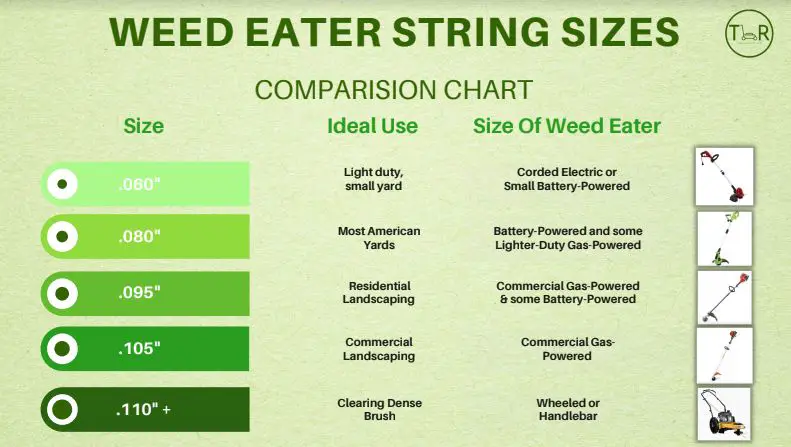Choosing the right size weed eater string is crucial for optimal performance of your weed trimmer. The string size needs to match the specifications of your weed whacker model. In this article, we will discuss the factors to consider when selecting string and how to determine the right size for your weed wacker.
Page Contents
- 1 What Are the Common String Sizes?
- 2 How to Determine the Right String Size
- 3 Factors that Determine Ideal String Size
- 4 Benefits of the Right Size String
- 5 Choosing Between Metallic and Non-Metallic Strings
- 6 Thickness Recommendations for Specific Trimmer Types
- 7 Tips for Choosing the Optimal String Diameter
- 8 Conclusion
What Are the Common String Sizes?
Weed eater string comes in a range of diameters, usually measured in millimeters or inches. The most common sizes are:
- 1.4mm – Used for handheld trimmers and small electric trimmers
- 2.0mm – Suitable for most gas-powered trimmers
- 2.4mm – For heavy-duty gas trimmers
- 2.7mm – Extra thick and durable for tougher weeds
- .065″ – Same as 1.6mm
- .080″ – Same as 2.0mm
- .095″ – Same as 2.4mm
- .105″ – Same as 2.7mm
As a general rule, more powerful gas trimmers use thicker string (2.4mm and up) while electric and battery-powered models usually use the thinner gauges like 1.4mm or 2.0mm.
How to Determine the Right String Size
Here are the steps to find the correct string diameter for your weed wacker:
- Check your owner’s manual – The manual will specify the appropriate string size for your model.
- Look for markings on the spool or weed wacker – There may be guidance etched into the string spool or printed elsewhere on the tool indicating the string diameter.
- Measure the existing string – If your trimmer already has string loaded, simply measure the diameter in mm or inches.
- Match the bump head – Insert different string sizes into the bump head and see which one fits properly without being too tight or loose.
- Ask an expert – Consult a trained salesperson at your local hardware store or look up specifications online to find your model’s string size.
When in doubt, the 2.0mm or .080″ size is usually a safe bet for most standard gas-powered string trimmers.
Factors that Determine Ideal String Size
The right string thickness depends on several factors:
- Trimmer motor power – More powerful motors require thicker string that can handle faster tip speeds.
- Cutting swath – Wider cutting swaths need thicker string to maintain momentum and not slow down.
- Weed density – Thicker string is needed for heavy weeds and brush.
- Feed system – Bump heads need more flexible, thinner string while auto-feed heads accommodate thicker diameters.
Additionally, the string shape (twisted, serrated, multi-sided etc.) impacts cutting effectiveness. But the baseline rule is – the more rugged the vegetation you need to trim, the thicker the string you need.
Benefits of the Right Size String
Picking the manufacturer-recommended string diameter offers the following advantages:
- Improves cutting efficiency
- Maximizes trimmer motor performance
- Reduces strain on the motor
- Minimizes string wear and breakage
- Increases string life span
- Enables faster trimming of dense growth
- Results in a smoother cut
On the other hand, using the wrong gauge string can lead to overworked motors, frequent string changes, haphazard cuts and frustration while trimming.
Choosing Between Metallic and Non-Metallic Strings
Weed wacker strings are made from various materials:
| Material | Pros | Cons |
|---|---|---|
| Nylon |
|
|
| Polymer blends |
|
|
| Plastic-coated metal |
|
|
While metal-based strings last longer, they are noisy and can potentially damage objects they accidentally strike. For home use, standard nylon or polymer strings are recommended for safety and quiet operation.
Thickness Recommendations for Specific Trimmer Types
Handheld Weed Whackers
Lightweight handheld trimmers are designed for edging and precision trimming. Use string diameters between 1.2mm to 2.0mm. Thicker string can overwhelm the compact motor.
Electric Weed Eaters
For average-sized yards, most corded and cordless electric weed whackers work best with 1.5mm to 2.0mm string. Match the diameter to the electric motor power.
Gas-Powered Weed Whackers
Gas trimmers pack more cutting power and require thicker string. The most common sizes used are 2.4mm for regular duty and 2.7mm for heavy duty brush cutting.
Tips for Choosing the Optimal String Diameter
- Consider the largest vegetation you need to cut – Small grass vs. thick brush
- Factor in the cutting swath width – Wider swaths need thicker lines
- Match string weight to trimmer motor power
- Review string specs on the spool packaging
- Start with lower diameters and test what works best
- Avoid line that’s too thick or thin for your model
- Buy string spools that specifically mention your trimmer brand and model
Conclusion
Choosing the manufacturer-recommended string thickness is key for proper weed trimmer function. The ideal diameter depends on motor power, cutting swath, and vegetation type. Gas models need thicker line (2.4 – 2.7mm) than electric trimmers. For best results, match the string to your weed wacker’s specifications and testing different sizes to determine the optimal gauge.
